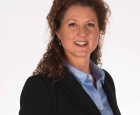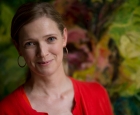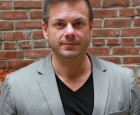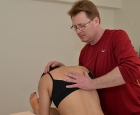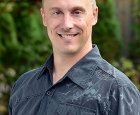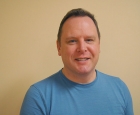
Features
Education
Leadership
Meet the experts: Massage Therapy Canada’s editorial advisory board
Massage Therapy Canada magazine has invited thought leaders in the massage therapy profession to help shape the publication’s editorial direction. These industry experts will comprise the magazine’s newly formed editorial advisory board.
April 18, 2017 By Mari-Len De
Get to know the new Massage Therapy Canada editorial advisory board members.
PAUL KOHLMEIER
Paul Kohlmeier has been a registered massage therapist in Manitoba for nearly two decades. With a bachelor’s degree in physical education and advanced massage therapy diploma from the Wellington College of Remedial Massage Therapies, Kohlmeier has been a very active participant in the massage therapy community, particularly in the Massage Therapy Association of Manitoba (MTAM).
“We have the opportunity through the associations to engage that group of RMTs, making it our biggest opportunity,” says Kohlmeier who has volunteered with the MTAM for a number of years, including as president and secretary-treasurer. He is also a member of the IN-CAM’s special interest group for massage therapy.
Kohlmeier is also a registered acupuncturist and has been a volunteer in the board of directors of the Manitoba Professional Acupuncture Association.
Kohlmeier’s interest is in clinical work, focusing on muscle energy techniques. He is also interested in oncology, where he believes the profession can make a difference in the lives of people going through the most difficult moments in their lives.
Research is another area that he is passionate about. He dreams of creating a professional research network that involves RMTs and their work with patients.
“It could show us where we do well, where we do not, and point to what needs to be studied. It could be that we are doing something amazing but it doesn’t happen often enough to bring it to anyone’s attention,” Kohlmeier says.
He believes one of the biggest challenges facing RMTs in Canada is the seeming disconnectedness of the profession, as many practitioners work alone, at home or in small clinics, with very little opportunity to network and build professional relationships. “This disconnect keeps the profession from speaking with a unified voice.”
Kohlmeier believes the massage therapy profession will see regulation in all Canadian provinces someday, which can pave the way for a national agreement and procedure that will enable practice mobility and better opportunities for massage therapists.
SCOTT ANDREW
Scott Andrew is the instructor and clinic director at the Atlantic College of Therapeutic Massage, in Fredericton, N.B. He has been in practice as a self-employed RMT since 1999, with a degree in Biology from Western University in London, Ont.
“The idea of pursuing a career in health care was likely planted when I worked as a porter at the Royal Ottawa Regional Rehabilitation Centre in Ottawa, while in high school. Seeing individuals who were facing incredible physical challenges instilled in me a great appreciation for the fragility and resiliency of the human body,” Andrew says.
Over the course of his career, Andrew has had opportunities to work alongside health-care professionals in various specialities including: osteopathy, orthopaedic surgery, primary care medicine, chiropractic, physiotherapy, naturopathic medicine, pedorthics, and occupational therapy.
“Moving from Ontario to New Brunswick eight years ago provided an opportunity for me to see how the profession is viewed by other health-care providers and the public in a non-regulated province,” Andrew says. As current site surveyor for the Canadian Massage Therapy Council for Accreditation, Andrew’s goal is to help in the establishment of a national standard of competency for the massage therapy profession.
His passion for the education of future massage therapy professionals has grown in recent years, believing that “the more deeply students understand they are members of a health-care profession the deeper their level of self-respect and involvement in our profession becomes.”
Clinical research is another area of interest for Andrew. He spent two years at the University of New Brunswick in Fredericton examining the effects of massage therapy on individuals with fibromyalgia.
If there is one thing he would like to do to help advance the profession, it’s to help foster mentorships for therapists, especially in jurisdictions that have yet to achieve professional regulation. Regulated provinces, he says, can provide mentorship for those who are looking to build up their level of confidence.
“This dialogue needs to be a continual conversation devoid of regional bias and protectionism. I wish every therapist could experience what it is like to sit at a discussion table with supportive, intelligent and committed therapists from across the country and see just how similar we are,” Andrew says.
BETH BARBERREE
Beth Barberree began her career as a massage therapist in Alberta in 1995. Throughout her successful practice, she also dedicated many years as a leader in the professional community and an advocate for high standards of practice.
She has served as president of the Massage Therapist Association of Alberta and is currently the president and board chair of the Alberta Support Council for Massage Therapy. She has been a volunteer with the IN-CAM Massage Therapy Special Interest Group since 2011.
Barberree is among Alberta RMTs working and advocating for professional regulation in the province.
“One thing that most strongly drives me is the need for consistent standards for massage therapy education and practice to be adopted across the country,” she said. “I believe that ensuring open, ongoing effective collaboration among massage therapy organizations representing all facets of the profession across the country is crucial to realizing this vision.”
Barberree completed her master of arts in health leadership from Royal Roads University in Victoria, B.C., in 2016 and is pursuing leadership and management consulting work for various organizations. She has written for various publications, including Massage Therapy Canada. She has presented at various Canadian and international conferences, including at the International Massage Therapy Research Conference.
Asked about what she believes is the biggest challenge facing massage therapy professonals today, Barberree remarks, “I think that much of the activity that occurs in the best interest of advancing the profession still occurs in silos. Egos need to be left at the door and focus on what is best for the profession needs to be the priority.”
For her part, this Alberta RMT wants to see a “shared vision” in the profession that will guide decision making among leaders across Canada.
“Collaborative leadership best practices need to guide interactions among groups, both within the massage therapy profession and with our external stakeholders as well. Open dialogue based on building trusting relationships, difficult yet crucial conversations, and respectful and sustainable change management practices are key to this process,” Barberree points out.
DONELDA GOWAN-MOODY
Clinical work, research and patient education are three areas that guide Donelda Gowan-Moody’s massage therapy practice. Since completing her massage therapy diploma in 1987 from the Canadian College of Massage and Hydrotherapy in Sutton, Ont., Gowan-Moody has built up a career with significant focus on research and pursuing higher education. Aside from her massage therapy diploma, she has a bachelors degree in psychology, a master’s of science and is currently completing a doctor of philosophy in community and population health science at the University of Saskatchewan.
“My goal for the profession is that massage therapy is unerringly perceived of and utilized as a health promotion profession, treatment provider profession, and health management profession that is well-respected and well-understood by practitioners, users, other health-care providers, and all policy and decision-makers,” Gowan-Moody says.
Throughout her career Gowan-Moody, who now resides in Saskatoon, has engaged in numerous research initiatives and has been published in several publications, including peer-reviewed articles in the Journal of Complementary and Integrative Medicine and the International Journal of Therapeutic Massage and Bodywork.
Her current research focus involves issues of patient safety, including adverse events. She believes studying good patient outcomes is informed by investigation of poor outcomes, as “understanding one aids in understanding and articulating the other.”
As a perpetual scholar, Gowan-Moody believes learning from each other is the profession’s biggest opportunity. “We can learn from the education, research, practice and policy of both the dominant biomedical care provider groups (physicians, nurses, pharmacists) and traditional, alternative, and complimentary care provider groups… Each of these groups are at different places in modern scholarship and the dissemination and development of knowledge.”
JASON WHITE
Jason White is both a certified athletic therapist and sport massage therapist. His practice is based in Toronto, and has worked as team therapist in a number of major sporting events, including the 2015 Pan Am and Parapan Am Games, the Commonwealth Games, and both the Canada Winter and Summer Games.
He is actively involved with the Canadian Sport Massage Therapy Association (CSMTA), currently serving as education chair for the Ontario chapter and sits on the CSMTA national certification committee.
Like many leaders in the profession, White wants to see standardization and shared best practices for massage therapy across Canada.
“With an aging population, with needs that will continue to change, as health-care professionals, we’ll be called upon to support those changing needs and we need to be ready,” White notes. “I’d like to see more research around massage therapy. More research will lead us to greater insights for how we can care for our patients, provide more value and be more effective.”
White’s interest in sport massage began early on when, as a competitive athlete he witnessed and benefitted from various treatments for periodic injuries and musculoskeletal conditions delivered by an array of health professionals. “I knew that a career in sports medicine was the right path for me.”
In addition to being a certified athletic therapist and sport massage therapist, White is also a registered kinesiologist, a contemporary medical acupuncture practitioner, and a craniosacral therapist – allowing him to bring a multidisciplinary approach to patient care.
White’s passion is in working with high performance athletes. Being an athlete himself allows him to understand the physical, emotional and psychological demands that sport places on an athlete, and enables him to be more effective in treating athletes as a “whole patient.”
“From injury through rehab to healing, from pre-season through the season, often to podium, the satisfaction of knowing that I have helped them achieve success is what drives me,” White says.
White believes massage therapists need more advanced education – beyond diploma-level – to match other health-care professions, advocating for a degree-level program or higher for massage therapy.
MIKE DIXON
Vancouver-based RMT Mike Dixon has been in practice for about 30 years. He is an educator, a published author and international presenter in massage therapy continuing education. He is the senior practical advisor at the West Coast College of Massage Therapy, and has also taught at the Boucher Institute of Naturopathic Medicine.
Dixon has trained more than 2,000 massage therapists and naturopathic doctors. He is very focused on orthopedic assessment and treatments. “I have found that working with alignment of the skeleton, correcting joint and muscle dysfunction, provided so many of my patients with return to health and optimal function. These techniques include: tractions mobilizations, joint mobilizations, muscle energy techniques, fascial techniques, stretching, end range loading and nerve mobilization, to mention a few. With that being said, I do not limit myself to an orthopedic practice and enjoy a diversity of patient profiles and cases.”
In 2006, he published his textbook, Joint Play the Right Way for the Axial Skeleton, which covers a multidimensional approach to the treatment of the spine and the pelvis.
As with many in the profession, Dixon hopes a national standardized education and regulation for massage therapists – with a minimum of 2,500 hours of education – will enable cross-jurisdiction professional mobility for therapists.
Asked about some of the challenges facing the profession today, Dixon expresses concern about the potential implications of health-care fraud to the viability of the profession.
Dixon, however, remains confident about the “bright, smart and talented people” entering the massage therapy profession.
“These therapists will take this profession to a new level, to include research, best practices, and trained college and university educators.”
Mari-Len De Guzman is the editor of Massage Therapy Canada magazine. You can contact her at mdeguzman@annexweb.com.
Print this page
